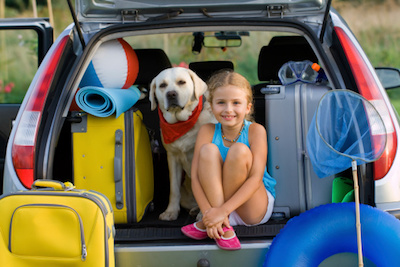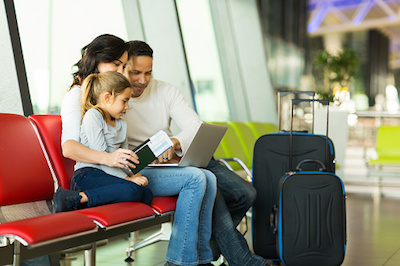View All Articles
10 Ways to Help Your Child Travel During the Holidays
Traveling during the holidays can add an additional layer of tasks to manage and challenges to overcome, especially if you are traveling with children. Whether by plane, train or automobile, here are some tips to supporting your child with the goal of minimizing their stress and ensuring a happy holiday for everyone.
-
Prepare your child for the journey.
Children are creatures of habit and feel most secure in a routine. A week or so before you begin your journey, tell your child about your travel plans including timing, mode of transportation, any changes to their schedule that will be necessary and why you are traveling. This will help set a foundation for your child to understand the preparations and be a willing participant in the adventure. -
Remind your child of the upcoming journey.
“3 more sleeps until we go to the airport.” Parents likely have plans made well in advance with details of when to pack the suitcase, and the like. Younger children do not have the same capacity to understand or manage time and will benefit from gentle reminders so that they can pace with you and help them build skills around time management. -
Provide your child appropriate choices about what to take along.
Let them help pack their suitcase with items that they prefer. This offers parents an opportunity to learn more about how their child thinks and views the world as well as an opportunity to build skills related to independence. Children may feel more comfortable away from home if they have their favorite pajamas or outfit to wear.
-
Anticipate your child’s comfort needs.
Perhaps your child is attached to a particular item that is better brought on to the plane rather than packed in checked luggage. If your child has sensory challenges, noise cancelling headphones, sunglasses, or toys with their favorite texture can help them self-soothe and manage the changes in the environment. Similarly, if your child experiences motion sickness, ask your pediatrician about acupressure bands, aromatherapy or medications to quell their queasy stomachs. -
Talk with your child about their excitement and their worry.
 Traveling is exciting for many and children may often have things they are anticipating or looking forward to during the trip. Talking with your child will help give parents clues to making the adventure more fun for them, particularly while waiting in line at the airport or when the novelty of sitting in the car for a long period of time is wearing off. Similarly, ask your child about their worries related to the journey. With intense media exposure regarding tragedy, children may have worries about going into public spaces like airports or train stations, flying in an airplane or taking a long car ride out of fear of injury or separation. By talking specifically about their worries, parents can be better prepared to anticipate and identify parts of the journey that may cause their child to respond fearfully and be less calm and cooperative.
Traveling is exciting for many and children may often have things they are anticipating or looking forward to during the trip. Talking with your child will help give parents clues to making the adventure more fun for them, particularly while waiting in line at the airport or when the novelty of sitting in the car for a long period of time is wearing off. Similarly, ask your child about their worries related to the journey. With intense media exposure regarding tragedy, children may have worries about going into public spaces like airports or train stations, flying in an airplane or taking a long car ride out of fear of injury or separation. By talking specifically about their worries, parents can be better prepared to anticipate and identify parts of the journey that may cause their child to respond fearfully and be less calm and cooperative. -
Provide guidance and expectation regarding their behavior.
Children are more likely to behave appropriately in public settings if they know what behavior is expected of them (inside voices, etc.), and what rules apply to the new environment (seatbelts must be worn). By preparing your child for these requirements ahead of time, it can offer them an opportunity to practice the behavior, ask clarifying questions, and help them build social skills regarding appropriate interactions in public settings and be successful at meeting your expectations. -
Pack snacks.
As adults, we often grab a cup of coffee for the road or while waiting in the airport. And although we don’t often conceptualize it as a snack, a child may see it as something additional, above and beyond meal time, and therefore, a snack. Packing snacks can help your child if the time between meals is longer than usual based on travel times, ensure that healthier options are available, and make managing any dietary restrictions easier. Parents can model good habits by sharing healthy snacks with their child as well. -
Leverage the creativity of a diverse group of play materials.
Children love to engage their imaginations and activities that can spark their creativity may keep them calm and content longer than a movie that has no active engagement. Look for art kits that come in self-contained travel packs, interactive games, or look and find type books. -
Engage the five senses.
Older children may enjoy making a travel log about their adventure. Collecting travel tickets, receipts and writing about their experiences in a journal can help them be more engaged in the process of traveling. Creating opportunities for taking pictures can help them create a memory book when they return home.
-
Share in the experience with your child.
Talk with your child throughout the journey about their experience. The classic ‘I spy with my little eye’ game or asking your child ‘I wonder…’ questions can be a fun and imaginative way to pass the time. Don’t worry that the questions or answers aren’t logical or factually correct. In fact, the sillier the response, the more engaging the games can be for both parent and child.






